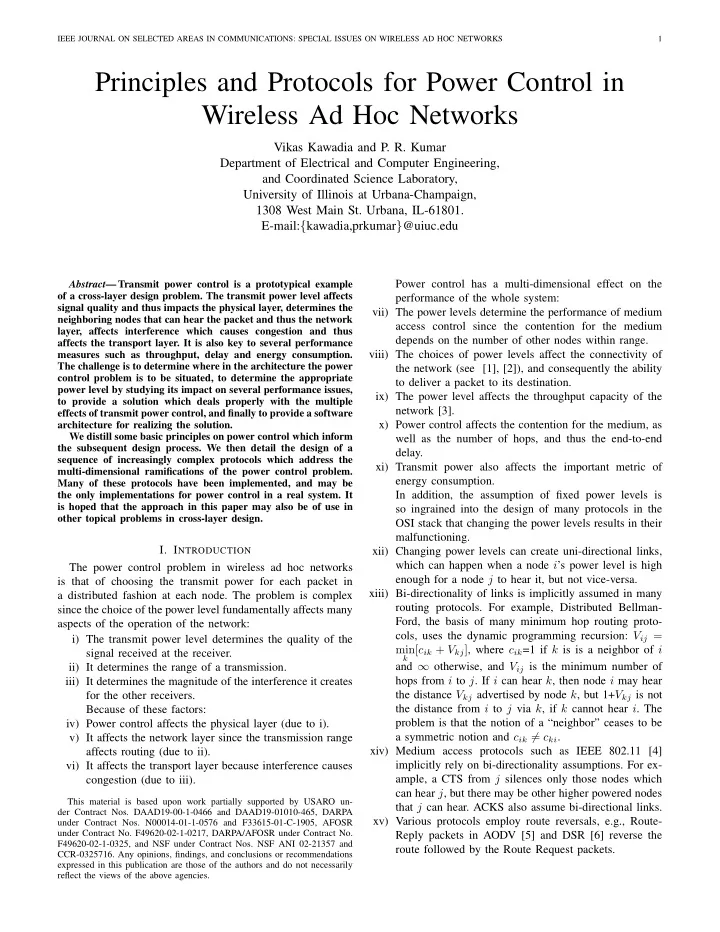

IEEE JOURNAL ON SELECTED AREAS IN COMMUNICATIONS: SPECIAL ISSUES ON WIRELESS AD HOC NETWORKS 1 Principles and Protocols for Power Control in Wireless Ad Hoc Networks Vikas Kawadia and P. R. Kumar Department of Electrical and Computer Engineering, and Coordinated Science Laboratory, University of Illinois at Urbana-Champaign, 1308 West Main St. Urbana, IL-61801. E-mail: { kawadia,prkumar } @uiuc.edu Power control has a multi-dimensional effect on the Abstract — Transmit power control is a prototypical example of a cross-layer design problem. The transmit power level affects performance of the whole system: signal quality and thus impacts the physical layer, determines the vii) The power levels determine the performance of medium neighboring nodes that can hear the packet and thus the network access control since the contention for the medium layer, affects interference which causes congestion and thus depends on the number of other nodes within range. affects the transport layer. It is also key to several performance viii) The choices of power levels affect the connectivity of measures such as throughput, delay and energy consumption. The challenge is to determine where in the architecture the power the network (see [1], [2]), and consequently the ability control problem is to be situated, to determine the appropriate to deliver a packet to its destination. power level by studying its impact on several performance issues, ix) The power level affects the throughput capacity of the to provide a solution which deals properly with the multiple network [3]. effects of transmit power control, and finally to provide a software architecture for realizing the solution. x) Power control affects the contention for the medium, as We distill some basic principles on power control which inform well as the number of hops, and thus the end-to-end the subsequent design process. We then detail the design of a delay. sequence of increasingly complex protocols which address the xi) Transmit power also affects the important metric of multi-dimensional ramifications of the power control problem. energy consumption. Many of these protocols have been implemented, and may be In addition, the assumption of fixed power levels is the only implementations for power control in a real system. It is hoped that the approach in this paper may also be of use in so ingrained into the design of many protocols in the other topical problems in cross-layer design. OSI stack that changing the power levels results in their malfunctioning. I. I NTRODUCTION xii) Changing power levels can create uni-directional links, which can happen when a node i ’s power level is high The power control problem in wireless ad hoc networks enough for a node j to hear it, but not vice-versa. is that of choosing the transmit power for each packet in xiii) Bi-directionality of links is implicitly assumed in many a distributed fashion at each node. The problem is complex routing protocols. For example, Distributed Bellman- since the choice of the power level fundamentally affects many Ford, the basis of many minimum hop routing proto- aspects of the operation of the network: cols, uses the dynamic programming recursion: V ij = i) The transmit power level determines the quality of the min k [ c ik + V kj ] , where c ik =1 if k is is a neighbor of i signal received at the receiver. and ∞ otherwise, and V ij is the minimum number of ii) It determines the range of a transmission. hops from i to j . If i can hear k , then node i may hear iii) It determines the magnitude of the interference it creates the distance V kj advertised by node k , but 1+ V kj is not for the other receivers. the distance from i to j via k , if k cannot hear i . The Because of these factors: problem is that the notion of a “neighbor” ceases to be iv) Power control affects the physical layer (due to i). a symmetric notion and c ik � = c ki . v) It affects the network layer since the transmission range xiv) Medium access protocols such as IEEE 802.11 [4] affects routing (due to ii). implicitly rely on bi-directionality assumptions. For ex- vi) It affects the transport layer because interference causes ample, a CTS from j silences only those nodes which congestion (due to iii). can hear j , but there may be other higher powered nodes This material is based upon work partially supported by USARO un- that j can hear. ACKS also assume bi-directional links. der Contract Nos. DAAD19-00-1-0466 and DAAD19-01010-465, DARPA xv) Various protocols employ route reversals, e.g., Route- under Contract Nos. N00014-01-1-0576 and F33615-01-C-1905, AFOSR under Contract No. F49620-02-1-0217, DARPA/AFOSR under Contract No. Reply packets in AODV [5] and DSR [6] reverse the F49620-02-1-0325, and NSF under Contract Nos. NSF ANI 02-21357 and route followed by the Route Request packets. CCR-0325716. Any opinions, findings, and conclusions or recommendations expressed in this publication are those of the authors and do not necessarily reflect the views of the above agencies.
Recommend
More recommend